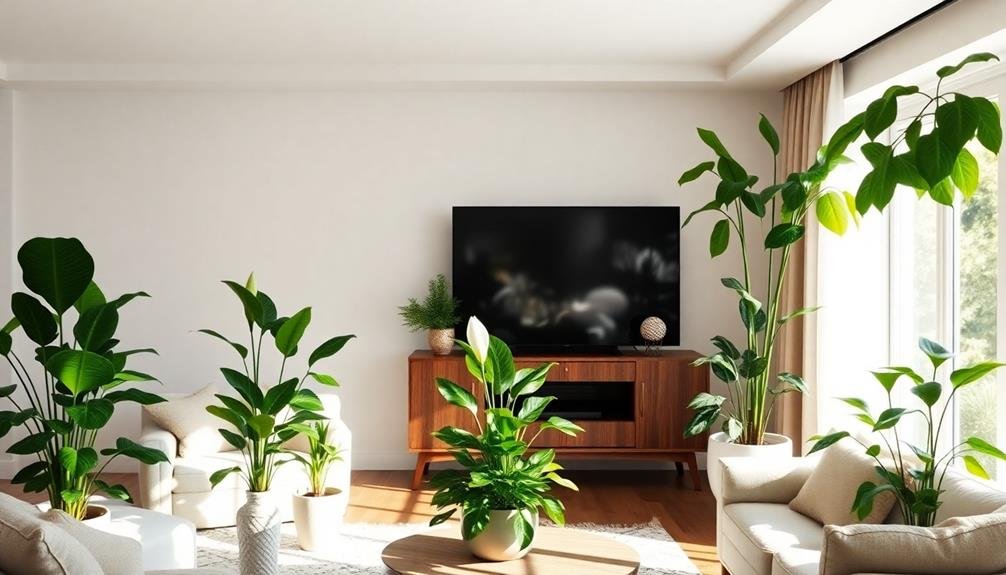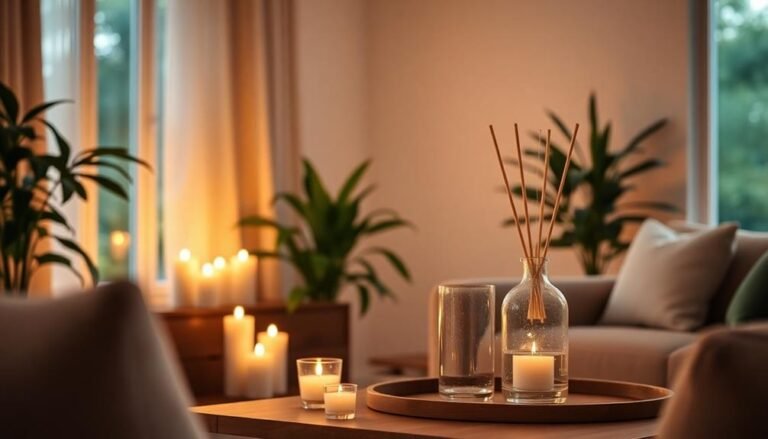If you're looking to boost your well-being, consider incorporating houseplants like the Snake Plant and Peace Lily into your space. The Snake Plant excels at cleaning indoor air by absorbing toxins, while releasing oxygen at night to promote better sleep. Peace Lilies not only filter harmful substances but also increase humidity, easing dry skin and respiratory issues. Add in a Spider Plant for exceptional air-purifying capabilities, or Lavender for its calming fragrance that reduces anxiety. Each of these plants contributes to a healthier environment, helping you feel more relaxed and focused. Discover more beneficial options that could enhance your home.
Snake Plant Benefits

When it comes to stress relief, the snake plant stands out as a top choice for your home. Known for its striking, upright leaves, this hardy plant not only enhances your space aesthetically but also contributes considerably to your well-being. One of the primary benefits of the snake plant is its ability to improve indoor air quality, making it an essential addition for anyone looking to breathe easier with houseplants. It efficiently absorbs toxins like formaldehyde and benzene, creating a healthier environment for you and your family.
Moreover, it's a low-maintenance plant, thriving in a variety of lighting conditions, so you won't have to worry about constant care. Just a little water now and then is all it needs, making it perfect for busy individuals. Additionally, the snake plant releases oxygen at night, which can promote better sleep, further helping to alleviate stress.
Imagine unwinding in your living room, surrounded by greenery that not only looks good but also works hard to purify the air. With its calming presence and numerous benefits, the snake plant is a fantastic addition to any home, providing you with a simple yet effective way to combat stress and enhance your overall living experience.
Peace Lily Properties

While the peace lily is often celebrated for its elegant white blooms, its properties extend far beyond beauty. This remarkable plant not only enhances your home decor but also actively contributes to a healthier indoor environment. One of its key attributes is its ability to filter harmful toxins from the air, including formaldehyde, benzene, and carbon monoxide. By incorporating a peace lily into your space, you're effectively improving air quality, which can lead to better overall well-being.
Moreover, peace lilies thrive in low light, making them an ideal choice for various indoor settings. They require minimal care—just keep the soil moist and provide occasional watering. Curiously, these plants also have a natural knack for increasing humidity, which can alleviate dry skin and respiratory issues.
Beyond their physical properties, peace lilies are known for their calming presence. Having one nearby can create a soothing atmosphere, helping to reduce stress and promote relaxation. By choosing a peace lily, you're not only brightening your space but also investing in a plant that supports your health and peace of mind in tangible ways.
Spider Plant Advantages

The spider plant, with its arching green leaves and cascading baby plants, offers numerous advantages that make it a favorite among indoor gardeners. First and foremost, it's known for its exceptional air-purifying capabilities. Studies show that spider plants can effectively remove harmful pollutants, such as formaldehyde and xylene, from the air, helping you breathe easier in your home. In fact, popular air-purifying plants like the spider plant can filter pollutants by up to 87% in just 24 hours, making them a crucial addition to your indoor space.
Moreover, spider plants are incredibly easy to care for. They thrive in a variety of lighting conditions, whether indirect sunlight or partial shade, making them suitable for almost any room. You won't need to worry about constant watering, either; these resilient plants can tolerate occasional neglect.
Additionally, the spider plant's ability to produce "pups" or baby plants is an exciting feature. These pups not only enhance the plant's aesthetic appeal but also allow you to propagate and share your greenery with friends and family.
Lastly, having a spider plant can contribute to your overall well-being. The act of caring for a living plant can provide a sense of purpose and reduce stress, making your environment feel more vibrant and alive. Embrace the spider plant, and enjoy its many benefits!
Lavender's Calming Effects

In addition to the benefits of spider plants, incorporating lavender into your indoor space can considerably enhance your stress relief efforts. Known for its soothing fragrance, lavender has been shown to reduce anxiety and promote relaxation. When you inhale its calming scent, you might notice a decrease in your heart rate and an overall sense of peace enveloping you.
Consider placing a lavender plant in your bedroom or workspace, where you can easily enjoy its benefits. Studies suggest that the aroma of lavender can help improve sleep quality, making it an excellent choice for those restless nights. You might also find that keeping a lavender sachet in your drawers or closet can infuse your clothing with a gentle scent, creating an inviting atmosphere.
Moreover, taking care of a lavender plant can become a therapeutic ritual in itself. As you water and prune it, you engage in mindfulness, bringing your focus to the present moment. This simple act can be a powerful tool for stress management, allowing you to disconnect from the pressures of daily life. By embracing lavender, you're not just adding beauty to your space; you're also nurturing your well-being.
Aloe Vera Uses

Aloe vera is more than just a pretty plant; it's a powerhouse of benefits that can enhance your health and well-being. This succulent isn't just easy to care for; it offers a range of uses that can make a real difference in your life. One of the most popular applications is its soothing gel, which can be applied to minor burns, cuts, and skin irritations. Just break a leaf, and you'll release the gel that cools and promotes healing.
You can also sip aloe vera juice for digestive health. Many people find that it helps alleviate issues like heartburn and bloating, making it a great addition to your wellness routine. Furthermore, studies suggest that aloe vera may boost your immune system, thanks to its rich vitamins and antioxidants.
If you're looking to improve your skincare regimen, consider products containing aloe vera for hydration and anti-aging benefits. You can easily incorporate this versatile plant into your daily life, whether you're using it for skin care or enjoying a revitalizing drink. With all these impressive uses, it's clear that aloe vera deserves a spot in your home.
Bamboo Palm Perks

Looking to boost your indoor air quality? The Bamboo Palm could be your perfect solution. This elegant plant isn't just a pretty addition to your space; it's also known for its impressive air-purifying abilities. Research shows that the Bamboo Palm effectively filters out harmful toxins like benzene, formaldehyde, and trichloroethylene, making your home a healthier environment.
You'll appreciate its versatility, as it thrives in low light and adapts well to various indoor conditions. That means you don't need to worry about direct sunlight or complex care routines. Just water it when the soil feels dry, and you're good to go!
Moreover, the Bamboo Palm adds a touch of tropical charm, creating a calming atmosphere that can help reduce stress. Picture yourself in a room filled with lush greenery, and you'll feel more relaxed instantly.
If you're looking to enhance your living space, consider placing a Bamboo Palm in your home office or bedroom. Not only will it purify the air, but it'll also elevate your mood, making it an excellent choice for anyone aiming to improve their indoor experience.
Pothos Plant Characteristics

If you're captivated by the idea of enhancing your indoor environment with greenery, the Pothos plant is another fantastic option to contemplate. Known for its heart-shaped leaves and trailing vines, this versatile plant thrives in various conditions, making it ideal for both beginners and seasoned plant enthusiasts. Its leaves can display a range of colors, including vibrant greens and beautiful variegated patterns, adding visual interest to your space.
Pothos plants are incredibly adaptable; they can grow in low light, although they flourish best in bright, indirect sunlight. Watering is simple—you only need to let the top inch of soil dry out before adding more. This forgiving nature means you won't stress over your watering schedule.
Moreover, Pothos plants are recognized for their air-purifying abilities. They can help eliminate indoor pollutants, contributing to a healthier living environment. Whether you hang them in a basket or let them cascade from a shelf, their climbing habit makes them a stylish addition to any room. With minimal care and maximum benefits, Pothos plants are a smart choice for anyone looking to boost their indoor atmosphere.
Frequently Asked Questions
How Many Plants Do I Need for Optimal Air Quality?
To achieve ideal air quality in your home, it's recommended to have one plant per 100 square feet. For smaller spaces, like a bedroom or office, one or two plants can greatly improve the atmosphere. Consider low-maintenance options like snake plants or pothos. Remember, the type of plants you choose can affect how well they filter the air, so select varieties known for their air-purifying qualities for the best results.
Can Houseplants Improve My Sleep Quality?
Yes, houseplants can enhance your sleep quality. They contribute to a calming environment, reducing stress and anxiety levels. For instance, certain plants, like lavender and jasmine, emit soothing scents that promote relaxation and can help you fall asleep faster. Additionally, plants improve air quality by increasing oxygen levels, which can lead to better sleep. Incorporating greenery into your bedroom not only beautifies the space but also fosters a more restful atmosphere.
Are There Any Houseplants Safe for Pets?
If you're looking for houseplants that are safe for pets, consider options like spider plants, Boston ferns, or areca palms. These plants not only brighten your space but also pose no danger to curious pets. Additionally, you might want to avoid common houseplants such as poinsettias and philodendrons, as they can be toxic. Always double-check plant safety before bringing a new green friend home to guarantee your furry companions stay healthy and happy.
How Often Should I Water Indoor Plants?
You should water indoor plants based on their specific needs, but a good rule of thumb is to check the soil moisture every week. Studies show that overwatering can lead to root rot, affecting about 30% of houseplants. For instance, if the top inch of soil feels dry, it's time to water. Always guarantee your pots have drainage holes, allowing excess water to escape, which helps keep your plants healthy and thriving.
What Is the Best Light Condition for Houseplants?
To provide the best light conditions for your houseplants, you need to take into account their specific needs. Most plants thrive in bright, indirect sunlight, while others prefer low-light environments. For instance, succulents and cacti enjoy direct sunlight, whereas ferns flourish in shadier spots. Always observe your plants; if their leaves start to yellow or drop, they might be getting too much or too little light. Adjust their placement accordingly to keep them healthy and vibrant.




